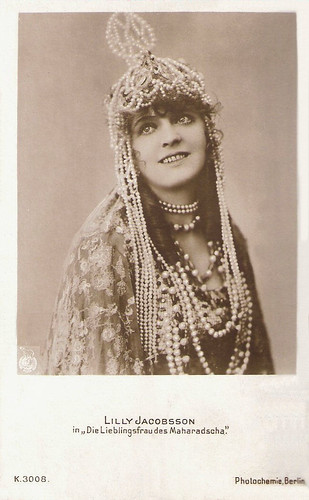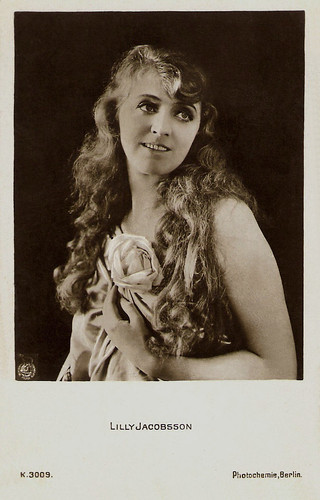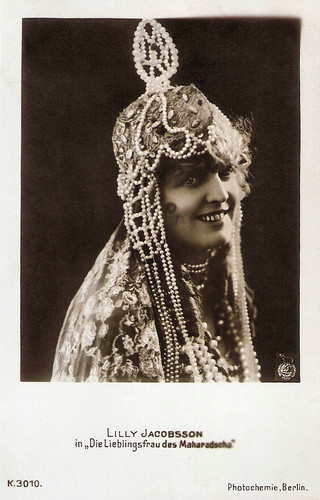Maharadjahens Yndlingshustru/The Maharaja’s Favourite Wife (Robert Dinesen, 1917) was a Danish orientalist melodrama produced by the Nordisk Film Kompagni. The stars were Gunnar Tolnaes as an Indian prince, and Lilly Jacobson as his love interest, the Danish Elly von Langen. The film was so popular that Nordisk produced a sequel. In Maharadjahens Yndlingshustru II/The Maharaja's Favourite Wife II (August Blom, 1919), Tolnaes and Jacobson returned. Photochemie in Berlin published postcards for both films. A German sequel followed in 1921 and a Danish remake in 1926, both with Tolnaes but without Jacobson who had left the film industry.

German postcard by Photochemie, Berlin, no. K. 1475. Photo: Nordisk. Lilly Jacobson in Maharadjahens Yndlingshustru/The Maharaja's Favourite Wife (Robert Dinesen, 1917).

German postcard by Photochemie, Berlin, no. K. 1917. Photo: Nordisk. Gunnar Tolnaes in Maharadjahens Yndlingshustru/The Maharaja's Favourite Wife (Robert Dinesen, 1917).

German postcard by Photochemie, Berlin, no. K. 1919. Photo: Nordisk. Gunnar Tolnaes and Lilly Jacobson in Maharadjahens Yndlingshustru/The Maharaja's Favourite Wife (Robert Dinesen, 1917).

German postcard by Photochemie, Berlin, no. K. 1976. Photo: Nordisk. Gunnar Tolnaes and Lilly Jacobson in Maharadjahens Yndlingshustru/The Maharaja's Favourite Wife (Robert Dinesen, 1917).
Maharadjahens Yndlingshustru/The Maharaja’s Favourite Wife (Robert Dinesen, 1917) was based on a script by Sven Gade. The film begins at a European seaside resort. Beautiful officer's daughter Elly von Langen (Lilly Jacobson) meets and falls in love with an elegant Indian maharajah (Gunnar Tolnaes). She has just turned down a marriage proposal from her cousin, Lieutenant Kuno von Falkenberg (Carlo Wieth). She secretly flees with the Maharajah to India.
There, to her regret, Elly is incorporated into his harem, and although she is given the status of favourite wife, she does not have her freedom. Some time later, von Falkenberg's ship arrives in India and the naval officers are invited to the maharajah's palace. When Elly recognizes her cousin, she first begs him to be freed. However, when the Maharajah allows her to choose and indirectly gives her proof of his great love, she decides at the last minute to stay with him.
In the 1910s, the Danish film industry was an international superpower and the productions of the Nordisk Film Kompagni were the most successful - especially in Germany. The studio heads at Nordisk hoped that Norwegian-born actor silent film star Gunnar Tolnaes would become as popular as their biggest star, Valdemar Psilander.
In 1913, Tolnaes started his film career for the Swedish company Svenska Biografteatern AB in Stockholm and worked there with legendary director Victor Sjöström. They made the silent dramas Halvblod/Half Breed (Victor Sjöström, 1913) with Karin Molander, Gatans barn/Children of the Streets (Victor Sjöström, 1914) starring Lili Beck, and En av de många/One of the Many (Victor Sjöström, 1915). He also worked with the other great director of the silent Swedish cinema, Mauritz Stiller.
Then Tolnaes moved to Copenhagen, where he was offered a contract at the Nordisk studio. He had an impressive career in Denmark. Immediately, Tolnaes was successful with Doktor X/Doctor X (1915) directed by Robert Dinesen. Tolnaes had his most famous performance for Nordisk in Maharadjahens Yndlingshustru/The Maharaja’s Favourite Wife (Robert Dinesen, 1917). Bedecked with jewels and military decorations in his Maharajah attire, gained immense popularity and the tale-telling nickname ‘The Women’s Favorite Maharajah’.
Tolnaes continued in such Nordisk productions as the Science-Fiction film Himmelskibet/400 Million Miles From Earth (Holger-Madsen, 1918). Another major success was the sequel of Maharadjahens Yndlingshustru/The Maharaja’s Favourite Wife (Robert Dinesen, Svend Gade, 1917), Maharadjahens Yndlingshustru II/The Maharaja's Favourite Wife II (August Blom, 1919), in which he reunited with Lilly Jacobson.

German postcard by Photochemie, Berlin, no. K. 2992. Photo: Nordisk. Gunnar Tolnaes and Lilly Jacobson in Maharadjahens Yndlingshustru II/The Maharaja's Favourite Wife II (August Blom, 1919).

German postcard by Photochemie, Berlin, no. K. 2993. Photo: Nordisk. Gunnar Tolnaes in Maharadjahens Yndlingshustru II/The Maharaja's Favourite Wife II (August Blom, 1919).

German postcard by Photochemie, Berlin, no. K. 2994. Photo: Nordisk. Gunnar Tolnaes in Maharadjahens Yndlingshustru II/The Maharaja's Favourite Wife II (August Blom, 1919).

German postcard by Photochemie, Berlin, no. K. 2995. Photo: Nordisk. Gunnar Tolnaes in Maharadjahens Yndlingshustru II/The Maharaja's Favourite Wife II (August Blom, 1919).
In 1916 Nordisk was looking for a new female star. Swedish actress Lilly Jacobson (also written as Lilly Jacobsson) was chosen from hundreds of competitors and became the leading actress in Maharadjahens Yndlingshustru/The Maharaja’s Favourite Wife (Robert Dinesen, Svend Gade, 1917). Jacobson had already starred in Swedish and Danish silent films by such directors as Eric Malmberg, Mauritz Stiller and Holger-Madsen.
In Maharadjahens Yndlingshustru, she played Elly von Langen who enters the harem of an Indian Maharaja. The film was a box office success in many countries. In Austria, Paimann’s Filmlisten warmly recommended cinema owners to book the film: "The story is gripping and highly dramatic; the acting and photography are excellent, the sets lavish and the harem scenes first-rate."
Jacobsson played in various Danish films, mostly directed by Holger-Madsen. These films include the Science-Fiction-film Himmelskibet/400 Million Miles From Earth (Holger-Madsen, 1918), Folkets ven/Friend of the People (Holger-Madsen, 1918), and Mod Lyset/Towards the Light (Holger-Madsen, 1918) starring Asta Nielsen.
Nielsen plays a cold, partying woman who neglects religion, but later on repents and becomes the wife of a preacher (Alf Blütecher) who cares for the poor. The film eventually resulted in Jacobson playing Ophelia in Asta Nielsen’s famous production of Hamlet (Svend Gade, Heinz Schall, 1921), in which Nielsen played the title role herself.
Hamlet was Lilly Jacobson's final film. She married Corbett Edwards, the manager of Odense Gasværk and director of Danske Gaskompagni and retired from acting. Jacobson then withdrew from the public eye and lived with her husband in Odense, Denmark, until his death in 1977.

German postcard by Photochemie, Berlin, no. K. 2996. Photo: Nordisk. Lilly Jacobson in Maharadjahens Yndlingshustru II/The Maharaja's Favourite Wife II (August Blom, 1919).

German postcard by Photochemie, Berlin, no. K. 3002. Photo: Nordisk. Gunnar Tolnaes in Maharadjahens Yndlingshustru II/The Maharaja's Favourite Wife II (August Blom, 1919)..

German postcard by Photochemie, Berlin, no. K. 3003. Photo: Nordisk. Gunnar Tolnaes in Maharadjahens Yndlingshustru II/The Maharaja's Favourite Wife II (August Blom, 1919).

German postcard by Photochemie, Berlin, no. K. 3004. Photo: Nordisk. Gunnar Tolnaes in Maharadjahens Yndlingshustru II/The Maharaja's Favourite Wife II (August Blom, 1919).
Maharadjahens Yndlingshustru/The Maharaja’s Favourite Wife was such a success that Nordisk made a sequel, Maharadjahens Yndlingshustru II/The Maharaja's Favourite Wife II (August Blom, 1919), again starring Gunnar Tolnaes and Lilly Jacobson.
It featured a different set of characters. In part II, the Maharaja of Baghalpur (Gunnar Tolnaes) has conquered a European woman, Gul (Lilly Jacobson), who has become his very dear sweetheart. The young finance advisor Armine Robert (Carl Worm) is anxious to know all about the romance and Gul.
In 1921 the German studio PAGU produced another sequel Die Lieblingsfrau des Maharadschas - 3. Teil/The Maharajah's Favourite Wife III (Max Mack, 1921) in which Aud Egede Nissen replaced Jacobson. Die Lieblingsfrau des Maharadscha was Tolnaes' first German film.
Gunnar Tolnaes then alternated acting in German films with Danish productions, until the end of the silent era. Most of his Danish films in the 1920s were directed by A.W. Sandberg.
Finally, Nordisk Film released a new film in the series, Maharadjahens yndlingshustru III//The Maharajah's Favourite Wife III (A.W. Sandberg, 1926). Sandberg's film was a slightly modified remake of Dinesen's original version. The film was made to mark the 20th anniversary of the founding of Nordisk. Tolnaes returned as the Maharajah and now Karina Bell played his love Elly.

German postcard by Photochemie, Berlin, no. K. 3006. Photo: Nordisk. Gunnar Tolnaes in Maharadjahens Yndlingshustru II/The Maharaja's Favourite Wife II (August Blom, 1919).

German postcard by Photochemie, Berlin, no. K. 3008. Photo: Nordisk. Lilly Jacobson in Maharadjahens Yndlingshustru II/The Maharaja's Favourite Wife II (August Blom, 1919).

German postcard by Photochemie, Berlin, no. K. 3009. Photo: Nordisk.Lilly Jacobson in Maharadjahens Yndlingshustru II/The Maharaja's Favourite Wife II (August Blom, 1919).

German postcard by Photochemie, Berlin, no. K. 3010. Photo: Nordisk. Lilly Jacobson in Maharadjahens Yndlingshustru II/The Maharaja's Favourite Wife II (August Blom, 1919).
Sources: Mariann Lewinsky (Il Cinema Ritrovato), Det Danske Filminstitut (Danish) TMDB, Wikipedia (German) and IMDb.

German postcard by Photochemie, Berlin, no. K. 1475. Photo: Nordisk. Lilly Jacobson in Maharadjahens Yndlingshustru/The Maharaja's Favourite Wife (Robert Dinesen, 1917).

German postcard by Photochemie, Berlin, no. K. 1917. Photo: Nordisk. Gunnar Tolnaes in Maharadjahens Yndlingshustru/The Maharaja's Favourite Wife (Robert Dinesen, 1917).

German postcard by Photochemie, Berlin, no. K. 1919. Photo: Nordisk. Gunnar Tolnaes and Lilly Jacobson in Maharadjahens Yndlingshustru/The Maharaja's Favourite Wife (Robert Dinesen, 1917).

German postcard by Photochemie, Berlin, no. K. 1976. Photo: Nordisk. Gunnar Tolnaes and Lilly Jacobson in Maharadjahens Yndlingshustru/The Maharaja's Favourite Wife (Robert Dinesen, 1917).
Gunnar Tolnaes
Maharadjahens Yndlingshustru/The Maharaja’s Favourite Wife (Robert Dinesen, 1917) was based on a script by Sven Gade. The film begins at a European seaside resort. Beautiful officer's daughter Elly von Langen (Lilly Jacobson) meets and falls in love with an elegant Indian maharajah (Gunnar Tolnaes). She has just turned down a marriage proposal from her cousin, Lieutenant Kuno von Falkenberg (Carlo Wieth). She secretly flees with the Maharajah to India.
There, to her regret, Elly is incorporated into his harem, and although she is given the status of favourite wife, she does not have her freedom. Some time later, von Falkenberg's ship arrives in India and the naval officers are invited to the maharajah's palace. When Elly recognizes her cousin, she first begs him to be freed. However, when the Maharajah allows her to choose and indirectly gives her proof of his great love, she decides at the last minute to stay with him.
In the 1910s, the Danish film industry was an international superpower and the productions of the Nordisk Film Kompagni were the most successful - especially in Germany. The studio heads at Nordisk hoped that Norwegian-born actor silent film star Gunnar Tolnaes would become as popular as their biggest star, Valdemar Psilander.
In 1913, Tolnaes started his film career for the Swedish company Svenska Biografteatern AB in Stockholm and worked there with legendary director Victor Sjöström. They made the silent dramas Halvblod/Half Breed (Victor Sjöström, 1913) with Karin Molander, Gatans barn/Children of the Streets (Victor Sjöström, 1914) starring Lili Beck, and En av de många/One of the Many (Victor Sjöström, 1915). He also worked with the other great director of the silent Swedish cinema, Mauritz Stiller.
Then Tolnaes moved to Copenhagen, where he was offered a contract at the Nordisk studio. He had an impressive career in Denmark. Immediately, Tolnaes was successful with Doktor X/Doctor X (1915) directed by Robert Dinesen. Tolnaes had his most famous performance for Nordisk in Maharadjahens Yndlingshustru/The Maharaja’s Favourite Wife (Robert Dinesen, 1917). Bedecked with jewels and military decorations in his Maharajah attire, gained immense popularity and the tale-telling nickname ‘The Women’s Favorite Maharajah’.
Tolnaes continued in such Nordisk productions as the Science-Fiction film Himmelskibet/400 Million Miles From Earth (Holger-Madsen, 1918). Another major success was the sequel of Maharadjahens Yndlingshustru/The Maharaja’s Favourite Wife (Robert Dinesen, Svend Gade, 1917), Maharadjahens Yndlingshustru II/The Maharaja's Favourite Wife II (August Blom, 1919), in which he reunited with Lilly Jacobson.

German postcard by Photochemie, Berlin, no. K. 2992. Photo: Nordisk. Gunnar Tolnaes and Lilly Jacobson in Maharadjahens Yndlingshustru II/The Maharaja's Favourite Wife II (August Blom, 1919).

German postcard by Photochemie, Berlin, no. K. 2993. Photo: Nordisk. Gunnar Tolnaes in Maharadjahens Yndlingshustru II/The Maharaja's Favourite Wife II (August Blom, 1919).

German postcard by Photochemie, Berlin, no. K. 2994. Photo: Nordisk. Gunnar Tolnaes in Maharadjahens Yndlingshustru II/The Maharaja's Favourite Wife II (August Blom, 1919).

German postcard by Photochemie, Berlin, no. K. 2995. Photo: Nordisk. Gunnar Tolnaes in Maharadjahens Yndlingshustru II/The Maharaja's Favourite Wife II (August Blom, 1919).
Lilly Jacobson
In 1916 Nordisk was looking for a new female star. Swedish actress Lilly Jacobson (also written as Lilly Jacobsson) was chosen from hundreds of competitors and became the leading actress in Maharadjahens Yndlingshustru/The Maharaja’s Favourite Wife (Robert Dinesen, Svend Gade, 1917). Jacobson had already starred in Swedish and Danish silent films by such directors as Eric Malmberg, Mauritz Stiller and Holger-Madsen.
In Maharadjahens Yndlingshustru, she played Elly von Langen who enters the harem of an Indian Maharaja. The film was a box office success in many countries. In Austria, Paimann’s Filmlisten warmly recommended cinema owners to book the film: "The story is gripping and highly dramatic; the acting and photography are excellent, the sets lavish and the harem scenes first-rate."
Jacobsson played in various Danish films, mostly directed by Holger-Madsen. These films include the Science-Fiction-film Himmelskibet/400 Million Miles From Earth (Holger-Madsen, 1918), Folkets ven/Friend of the People (Holger-Madsen, 1918), and Mod Lyset/Towards the Light (Holger-Madsen, 1918) starring Asta Nielsen.
Nielsen plays a cold, partying woman who neglects religion, but later on repents and becomes the wife of a preacher (Alf Blütecher) who cares for the poor. The film eventually resulted in Jacobson playing Ophelia in Asta Nielsen’s famous production of Hamlet (Svend Gade, Heinz Schall, 1921), in which Nielsen played the title role herself.
Hamlet was Lilly Jacobson's final film. She married Corbett Edwards, the manager of Odense Gasværk and director of Danske Gaskompagni and retired from acting. Jacobson then withdrew from the public eye and lived with her husband in Odense, Denmark, until his death in 1977.

German postcard by Photochemie, Berlin, no. K. 2996. Photo: Nordisk. Lilly Jacobson in Maharadjahens Yndlingshustru II/The Maharaja's Favourite Wife II (August Blom, 1919).

German postcard by Photochemie, Berlin, no. K. 3002. Photo: Nordisk. Gunnar Tolnaes in Maharadjahens Yndlingshustru II/The Maharaja's Favourite Wife II (August Blom, 1919)..

German postcard by Photochemie, Berlin, no. K. 3003. Photo: Nordisk. Gunnar Tolnaes in Maharadjahens Yndlingshustru II/The Maharaja's Favourite Wife II (August Blom, 1919).

German postcard by Photochemie, Berlin, no. K. 3004. Photo: Nordisk. Gunnar Tolnaes in Maharadjahens Yndlingshustru II/The Maharaja's Favourite Wife II (August Blom, 1919).
Part 3 and another part 3
Maharadjahens Yndlingshustru/The Maharaja’s Favourite Wife was such a success that Nordisk made a sequel, Maharadjahens Yndlingshustru II/The Maharaja's Favourite Wife II (August Blom, 1919), again starring Gunnar Tolnaes and Lilly Jacobson.
It featured a different set of characters. In part II, the Maharaja of Baghalpur (Gunnar Tolnaes) has conquered a European woman, Gul (Lilly Jacobson), who has become his very dear sweetheart. The young finance advisor Armine Robert (Carl Worm) is anxious to know all about the romance and Gul.
In 1921 the German studio PAGU produced another sequel Die Lieblingsfrau des Maharadschas - 3. Teil/The Maharajah's Favourite Wife III (Max Mack, 1921) in which Aud Egede Nissen replaced Jacobson. Die Lieblingsfrau des Maharadscha was Tolnaes' first German film.
Gunnar Tolnaes then alternated acting in German films with Danish productions, until the end of the silent era. Most of his Danish films in the 1920s were directed by A.W. Sandberg.
Finally, Nordisk Film released a new film in the series, Maharadjahens yndlingshustru III//The Maharajah's Favourite Wife III (A.W. Sandberg, 1926). Sandberg's film was a slightly modified remake of Dinesen's original version. The film was made to mark the 20th anniversary of the founding of Nordisk. Tolnaes returned as the Maharajah and now Karina Bell played his love Elly.

German postcard by Photochemie, Berlin, no. K. 3006. Photo: Nordisk. Gunnar Tolnaes in Maharadjahens Yndlingshustru II/The Maharaja's Favourite Wife II (August Blom, 1919).

German postcard by Photochemie, Berlin, no. K. 3008. Photo: Nordisk. Lilly Jacobson in Maharadjahens Yndlingshustru II/The Maharaja's Favourite Wife II (August Blom, 1919).

German postcard by Photochemie, Berlin, no. K. 3009. Photo: Nordisk.Lilly Jacobson in Maharadjahens Yndlingshustru II/The Maharaja's Favourite Wife II (August Blom, 1919).

German postcard by Photochemie, Berlin, no. K. 3010. Photo: Nordisk. Lilly Jacobson in Maharadjahens Yndlingshustru II/The Maharaja's Favourite Wife II (August Blom, 1919).
Sources: Mariann Lewinsky (Il Cinema Ritrovato), Det Danske Filminstitut (Danish) TMDB, Wikipedia (German) and IMDb.
No comments:
Post a Comment